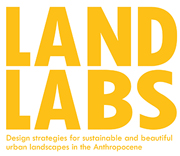About
The Doctoral Network “LANDLABS – Landscape Laboratories: Design strategies for sustainable and beautiful urban landscapes in the Anthropocene” (funded by the European Commission within the Marie Sklodowska-Curie Actions) operates across six landscape laboratories throughout Europe, exploring new perspectives on the interconnectedness between humans, animals, plants, water, air, soil, and technologies. Through an innovative site-based, research-through-design approach, LANDLABS offers young researchers the opportunity to contribute to the critical and urgent issue of the green transition of cities in alignment with the European Green Deal and the United Nations Goals of Sustainability.

LANDLABS concept

LANDLABS concept
Pertinence and innovative aspects of the research programme
Transdisciplinarity
LANDLABS combines disciplinary aspects (first, the perspective of the project´s guiding discipline landscape architecture; secondly, the analysis of disciplinary theories on interconnectedness) with interdisciplinary integration (joint reflection of six disciplinary theories on interconnectedness) and site-based work in the secondments with societal actors. This sums up to transdisciplinarity – a scientific mode which is highly demanded, yet rarely achieved in PhD programmes
Research Through Design
This method is unique for design disciplines and combines specific design work for a site with the creation of transferable knowledge. It has a lot of potential for complex, conflict-ridden, application-orientated questions, which is often the case for real-world topics such as landscapes. Research through Design is a consolidated and recognised, yet still a very “young” method and LANDLABS offers a rare opportunity to develop this method further in a doctoral network programme
Aesthetics
Working with aesthetics and the sensory experience of the environment is central to landscape architecture and the related design disciplines. Therefore, LANDLABS consciously addresses the concept of beauty although it can be considered controversial in a research context. The LANDLABS consortium considers ideas of beauty and aesthetic appreciation of the environment to be linked to sustainability, e.g. through eco-revelatory design or issues of care and caring. LANDLABS offers its DCs a unique opportunity to explore new ideas of beauty and to develop criteria for beautiful urban landscapes in the Anthropocene.
Background
The Anthropocene and LANDLABS
Interconnectedness and LANDLABS
It has become clear that the Anthropocene calls for a new understanding of urban landscapes and new methods for designing them, and LANDLABS goal is to train doctoral candidates for these tasks by (1) developing new interdisciplinary theory components and (2) developing transferable design strategies for designing sustainable and beautiful urban landscapes in the Anthropocene through transdisciplinary research-through-design in six concrete landscape laboratories all over Europe. These six sites are a major component in LANDLABS and the doctoral candidates study them intensively. They get regular advice from the associated partners who have a direct planning responsibility for these sites and all doctoral candidates have a five-months secondment with the associated partners.













